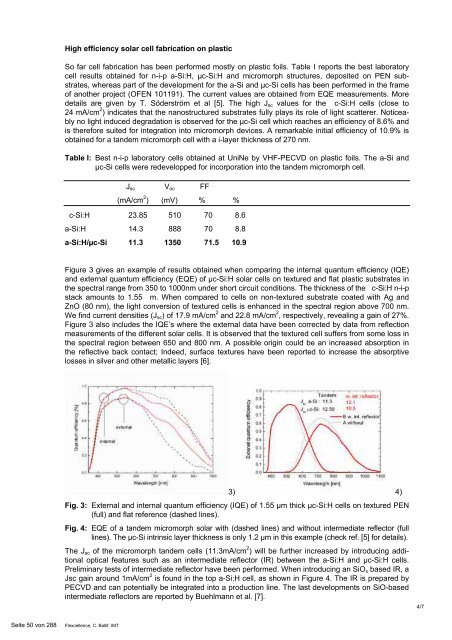Programm Photovoltaik Ausgabe 2008 ... - Bundesamt für Energie BFE
Programm Photovoltaik Ausgabe 2008 ... - Bundesamt für Energie BFE
Programm Photovoltaik Ausgabe 2008 ... - Bundesamt für Energie BFE
Create successful ePaper yourself
Turn your PDF publications into a flip-book with our unique Google optimized e-Paper software.
Seite 50 von 288<br />
High efficiency solar cell fabrication on plastic<br />
So far cell fabrication has been performed mostly on plastic foils. Table I reports the best laboratory<br />
cell results obtained for n-i-p a-Si:H, µc-Si:H and micromorph structures, deposited on PEN substrates,<br />
whereas part of the development for the a-Si and µc-Si cells has been performed in the frame<br />
of another project (OFEN 101191). The current values are obtained from EQE measurements. More<br />
details are given by T. Söderström et al [5]. The high Jsc values for the �c-Si:H cells (close to<br />
24 mA/cm 2 ) indicates that the nanostructured substrates fully plays its role of light scatterer. Noticeably<br />
no light induced degradation is observed for the µc-Si cell which reaches an efficiency of 8.6% and<br />
is therefore suited for integration into micromorph devices. A remarkable initial efficiency of 10.9% is<br />
obtained for a tandem micromorph cell with a i-layer thickness of 270 nm.<br />
Table I: Best n-i-p laboratory cells obtained at UniNe by VHF-PECVD on plastic foils. The a-Si and<br />
µc-Si cells were redevelopped for incorporation into the tandem micromorph cell.<br />
Jsc Voc FF �<br />
(mA/cm 2 ) (mV) % %<br />
�c-Si:H 23.85 510 70 8.6<br />
a-Si:H 14.3 888 70 8.8<br />
a-Si:H/µc-Si 11.3 1350 71.5 10.9<br />
Figure 3 gives an example of results obtained when comparing the internal quantum efficiency (IQE)<br />
and external quantum efficiency (EQE) of µc-Si:H solar cells on textured and flat plastic substrates in<br />
the spectral range from 350 to 1000nm under short circuit conditions. The thickness of the �c-Si:H n-i-p<br />
stack amounts to 1.55 �m. When compared to cells on non-textured substrate coated with Ag and<br />
ZnO (80 nm), the light conversion of textured cells is enhanced in the spectral region above 700 nm.<br />
We find current densities (Jsc) of 17.9 mA/cm 2 and 22.8 mA/cm 2 , respectively, revealing a gain of 27%.<br />
Figure 3 also includes the IQE’s where the external data have been corrected by data from reflection<br />
measurements of the different solar cells. It is observed that the textured cell suffers from some loss in<br />
the spectral region between 650 and 800 nm. A possible origin could be an increased absorption in<br />
the reflective back contact; Indeed, surface textures have been reported to increase the absorptive<br />
losses in silver and other metallic layers [6].<br />
3) 4)<br />
Fig. 3: External and internal quantum efficiency (IQE) of 1.55 µm thick µc-Si:H cells on textured PEN<br />
(full) and flat reference (dashed lines).<br />
Fig. 4: EQE of a tandem micromorph solar with (dashed lines) and without intermediate reflector (full<br />
lines). The µc-Si intrinsic layer thickness is only 1.2 µm in this example (check ref. [5] for details).<br />
The Jsc of the micromorph tandem cells (11.3mA/cm 2 ) will be further increased by introducing additional<br />
optical features such as an intermediate reflector (IR) between the a-Si:H and µc-Si:H cells.<br />
Preliminary tests of intermediate reflector have been performed. When introducing an SiOx based IR, a<br />
Jsc gain around 1mA/cm 2 is found in the top a-Si:H cell, as shown in Figure 4. The IR is prepared by<br />
PECVD and can potentially be integrated into a production line. The last developments on SiO-based<br />
intermediate reflectors are reported by Buehlmann et al. [7].<br />
Flexcellence, C. Ballif, IMT<br />
4/7







